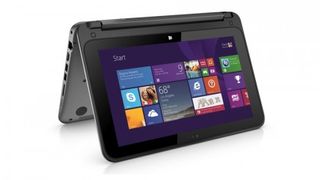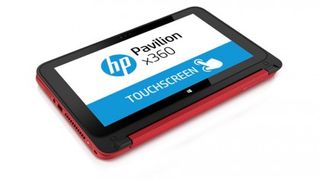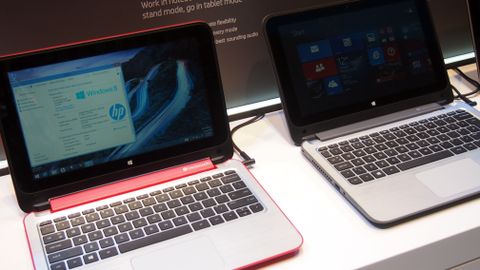Why you can trust TechRadar
- Cinebench 11: CPU: 0.74pts; OpenGL: 5.74fps
- 3D Mark: Ice Storm: 14025; Cloud Gate: 1086; Fire Strike: wouldn't run
- PC Mark 8 Home: 1101
- PC Mark 8 Home Power-Saving Battery: 3 hrs 37 mins
As expected, the performance of the HP Pavilion x360's processor leaves much to be desired. With a Cinebench score of 0.74, it's significantly behind even similarly priced larger laptops, including HP's own Pavilion TouchSmart 15-n070sa.
Interestingly, it's also far, far behind the Lenovo IdeaPad Yoga 2 11 that we tested, even though that machine also uses Silvermont-based processor technology. Its Pentium-branded processor is quad-core, which obviously helps, but it scored 1.77 in the Cinebench tests, which even bests some Core i3 Intel chips from fully-fledged laptops.

It's the same story with the graphics – the 3D Mark Cloud Gate score of 1086 is very low, and again massively lower than the HP Pavilion TouchSmart 15-n070sa, which is a similar price. For basic tablet-level games from the Windows Store (i.e. Cut the Rope) you'll get by without too much worry, but pretty much anything above that level is out.
Real world usage
What does all that mean in terms of real use? Well, you are limited to a degree by what you can run on this machine – video editing and any similarly intensive tasks are pretty much out, unless you have discovered an inner source of unending patience. But sub-£400, 11-inch hybrids have never exactly been designed for that anyway.
For general use, the HP Pavilion x360 is perfectly functional – it's just annoyingly slow at times. HP's usual suite of irritating software additions doesn't help, but you'll certainly notice that doing pretty much anything involves a wait, either for the hard drive to kick in or for the weak processor to work its way through the task.
Things like unzipping files take a surprisingly long time, and even loading websites just isn't very fast. But, as we say, it's all just a little slow, rather than catastrophically buggy or crashy.
The touchscreen is responsive, though, and the touch-friendly parts of the interface are fairly smooth. On the small screen, the desktop side of things is unsurprisingly awkward, but that's hardly a new thing for these sort of devices.
With the screen folded around into pure tablet mode, it's not exactly the most comfortable, ergonomic design, but it works. The keyboard deactivates when folded around like this, so that it's no problem if you mash the keys while gripping it.

Tablet shortcomings
The size and weight are far from the best for tablets – consider the iPad Air's 7.5mm thickness and 469g weight compared to the 22mm thickness and 1.4kg weight here. They're very different devices, but the point is that ultimately, the x360 just doesn't make that great a tablet.
The screen doesn't help either – the resolution is fine, and when viewed straight on, the colours are nice and bright enough. However, the viewing angles aren't brilliant, meaning that often if you pop it down on a handy surface in tablet mode, seeing what's on the screen is difficult.
Still, as a laptop, usability is actually rather good. The keyboard is 97% of full-size, and is very comfortable. The keys have a fairly short travel, but give a good amount of feedback, and it's easy to type without errors.

The trackpad is responsive and lacks the horrid finicky movement of many cheaper laptops, and gestures were recognised well. Furthermore, the Beats speakers do a good job, delivering clear, punchy sound befitting of a much larger machine.
Mediocre battery
Sadly, the x360 didn't end up impressing us on battery life, even with its low-power CPU. It's not the worst we've ever seen, lasting for 3 hours and 37 minutes on its Power Saver setting when running PC Mark 8's mix of uses including browsing, typing and video chatting.
However, the Lenovo Yoga 2 11 nearly doubled that, beating the 6 hour mark. In that context, HP has fumbled the ball somewhat here.

Wear OS 5: what we want to see, and all the leaks so far

The obscure little PC that wanted to be a big NAS — super compact Maiyunda M1 doesn't cost that much, offers up to 40TB SSD storage, runs Windows and has 4 Gigabit Ethernet ports

Image site Abload going offline reminds me of how much online content we've permanently lost
